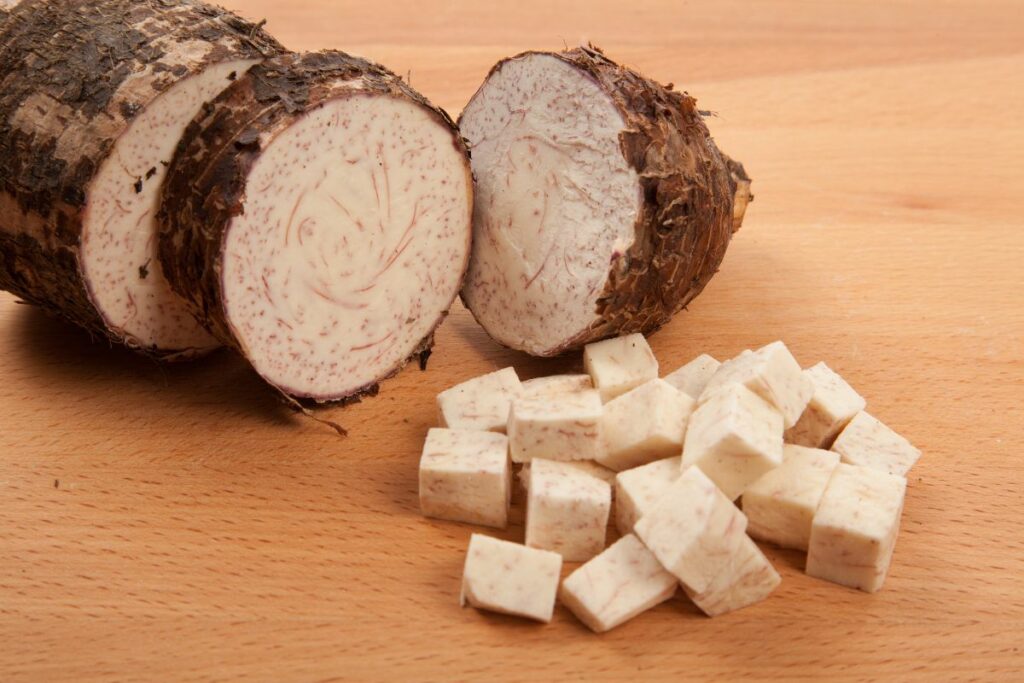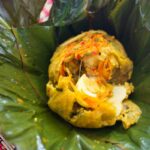Taro might not be a vegetable that a lot of people are familiar with, but it is a popular dish in parts of the world such as Southeast Asia. It is a root vegetable that is full of starch, so you can prepare and cook it in much the same way as you would a potato.

This tastes much like a sweet potato, although it has a slightly more earthy aftertaste. This comes with a brown exterior that is rough and nobbly. However, you can easily steam or broil this potato, although if you want a crispy skin, then you should bake it.
So, what else should you know about this root vegetable? What recipes can you use it in? What does Taro taste like? Well, we’ll give you all the information that you need to know about this dish, as well as some tips about cooking it to get the best flavor.
How Can You Use Taro?
Taro is classed as a root vegetable, although it is a stem. This vegetable comes with leaves that are toxic to ingest, so they are usually removed before they are sold at the market. This has brown outer skin, but when you cut into it, it is white with purple flecks.
This looks like a regular potato, although it is slightly darker. It has a creamy flesh that you can slice and dice in much the same way as you would a regular potato. You can have taro mashed, boiled, roasted, or baked.
This potato contains much less water than a regular potato or a sweet potato. You can get this from fruit and vegetable markets, although it is more common in Asian markets and Latin American grocery stores.
When you are shopping for taro, you’ll want to be sure that the vegetables that you are buying don’t contain any spots and are dark-skinned.
If your taro is white in patches, this could be a sign that they are not yet ripe enough. You can also buy powdered taro to sprinkle in desserts.
What Does Taro Taste Like?
This has a sweetness that is comparable to a sweet potato, although it is a lot milder. It has a nutty aftertaste, much unlike other root vegetables.
Taro are very starchy, so they should be washed before you serve them to get rid of the excess and allow them to cook in a much more healthy way.
Where Can You Find Taro?
Taro is commonly available in Latin American or Asian food markets, as they are a common ingredient in a lot of their dishes. You also might be able to order taro online, although make sure that they are either vacuum sealed or you are buying it in powdered form.
What Is The Best Method Of Preparing Taro?

Taro has many toxic elements, so you’ll want to make sure that you are preparing properly before consuming, otherwise, you might get very ill.
Wear gloves when you are preparing these vegetables, as even touching the surface can cause your skin to become irritated and red.
Wash the taro first so that the surface becomes soft. After you have done this, use a vegetable peeler to remove the top layer of skin. Once all the dark skin is removed, wash it under a cold tap once again to ensure all the dirt has gone.
Once you have completely white taro, you can then begin to chop or dice it as you see fit. If you chop it up, it will cook a lot quicker. You can also fry it in your frying pan, which is great if you are trying to make taro chips or wedges.
How Can You Cook Taro?
Once you have gone through this preparation stage, then you can start cooking it. Because taro is naturally drier, then this makes it a lot amenable to frying, although make sure that you add a little bit of oil before doing so.
You can make lots of different foods with taro and you can broil, boil, roast, fry, and mash it in much the same way as you can with a sweet or savory potato.
In parts of the world where Taro is popular, such as the Caribbean or the Pacific Islands, it is cubed and cooked in various spicy curries. There is a dish in Hawaii called poi, in which mashed taro is served on the side of meat.
You can also use taro to sweeten up certain bland foods and drinks. For example, it can be used in boba tea to give it more of a natural sweetness. Taro can be mashed up and used in ice cream, which is a great vegan alternative to dairy ice cream.
How Can You Best Store Taro?
Taro should be kept in a cool and dry place to avoid getting too much oxygen. We would recommend that you put it in a kitchen cupboard or basement at room temperature. Taro can get soft quite quickly, so you should cook it soon after you have purchased it.
Best Taro Recipes
There is a wide range of recipes that contain taro, some of which you might be surprised by. Here are just a few:
- Taro Ice Cream – All you need to make taro ice cream is some taro, sweet, condensed milk, and 2 cups of heavy cream. This is a simple and delicious dessert that is the perfect vegan alternative to dairy.
- Taro Fritters – these are delicious snacks that will only take you 30 minutes to make from start to finish. Mix in your taro with carrots, flour, garlic, and green onions, cook them in batter, and shape them into patties.
Conclusion
We hope that our guide to taro has given you a better idea of what is possible with this root vegetable. This is somewhere between a white potato and a sweet potato, so if you like that mid-level balance of sweet and savory, then we would recommend taro for you.
- How To Reheat A Cheesesteak - November 5, 2023
- What Are Three Must Have Kitchen Knives? - September 22, 2023
- How To Protect Edges Of Pie Crust - June 15, 2023








